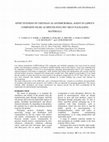Papers by Cornelia Vasile

Low density polyethylene (LDPE)/chitosan (CS) composites and stratified composites have been test... more Low density polyethylene (LDPE)/chitosan (CS) composites and stratified composites have been tested for minced poultry meat packaging according to well-known standard methods used in food industry. It has been established that the composites containing 3-6 wt% CS or nanocomposites containing chitosan/nanoclay and 0.5 wt% vitamin E show superior properties (with respect to appearance, smell, bouillon after boiling and sedimentation, pH, reaction with H 2 S and total number of germs), compared with commercially available foils, when applied to meat products. It was found that the number of germs decreased for meat packed in the obtained compositions by 10 4 -10 5 times. The best values have been obtained with stratified composites obtained by covalent bonding and covered with chitosan by electrospraying. The major characteristics of the LDPE foils, such as rheological behaviour, variation in crystallinity and permeability by treatment with chitosan and vitamin E, were studied, as they are important for packaging applications. The sensory methods, XRD, rheological and oxygen transmission rate analyses proved that the films accomplished all the requirements for minced poultry meat packaging.

Journal of Bioactive and Compatible Polymers, 2014
ABSTRACT Polyurethane–extracellular matrix membranes with bionanocomposites or coatings containin... more ABSTRACT Polyurethane–extracellular matrix membranes with bionanocomposites or coatings containing a small amount of biocompatible polymers such as hydrolyzed collagen, elastin, hyaluronic acid or chondroitin sulfate, and silver were obtained by solvent casting or electrospinning/electrospraying of the polyurethane–extracellular matrix–Ag formulations onto pure polyurethane membrane in order to achieve improved antibacterial biomaterials for urinary catheters. Using Fourier transform infrared spectroscopy, the interaction of the incorporated silver nanoparticles with polyurethane–extracellular matrix was found, while X-ray photoelectron spectroscopy and X-ray diffraction analyses ws used to determine the presence of metallic Ag for polyurethane membrane and Ag only in oxidized state for polyurethane–extracellular matrix membranes due to the stabilizing effect of polymeric components. The in vitro antimicrobial tests against Escherichia coli, Salmonella typhymurium, and Listeria monocytogenes were used for the evaluation of the antimicrobial efficiency.
International journal of biological macromolecules, Jan 8, 2016
The purpose of this study was to assess the biodegradation of poly(lactic acid) (PLA) and some pl... more The purpose of this study was to assess the biodegradation of poly(lactic acid) (PLA) and some plasticized PLA based systems by Trichoderma viride fungus, in liquid medium and controlled laboratory conditions. The studied systems were achieved using PLA, hydrolyzed collagen (HC) as biological macromolecules and other additives by melt processing procedure. PLA and the systems' biodegradability was examined by the weight losses of the samples (after 7 and 21 days of exposure) and FTIR-ATR, GPC, SEM analyses (after 21 fungus inoculation days). The thermogravimetry (TG-DTG) study showed that the thermostability of the samples decreased after biodegradation and was influenced by the chemical structure of the systems' components.
Cellulose Chemistry and Technology, 2006

Carbohydrate Polymers, 2016
Chitosan is a non-toxic, biocompatible, biodegradable natural cationic polymer known for its low ... more Chitosan is a non-toxic, biocompatible, biodegradable natural cationic polymer known for its low imunogenicity, antimicrobial, antioxidant effects and wound-healing activity. To improve its therapeutic potential, new chitosan-sulfonamide derivatives have been designed to develop new wound dressing biomaterials. The structural, morphological and physico-chemical properties of synthesized chitosan derivatives were analyzed by FT-IR, (1)H NMR spectroscopy, scanning electron microscopy, swelling ability and porosity. Antimicrobial, in vivo testing and biodegradation behavior have been also performed. The chitosan derivative membranes showed improved swelling and biodegradation rate, which are important characteristics required for the wound healing process. The antimicrobial assay evidenced that chitosan-based sulfadiazine, sulfadimethoxine and sulfamethoxazole derivatives were the most active. The MTT assay showed that some of chitosan derivatives are nontoxic. Furthermore, the in vivo study on burn wound model induced in Wistar rats demonstrated an improved healing effect and enhanced epithelialization of chitosan-sulfonamide derivatives compared to neat chitosan. The obtained results strongly recommend the use of some of the newly developed chitosan derivatives as antimicrobial wound dressing biomaterials.
Polimery, 2006
The compatibilizing effect of functionalized low density polyethylene (PE-LD) on PE-LD/polyamide ... more The compatibilizing effect of functionalized low density polyethylene (PE-LD) on PE-LD/polyamide 6 (PA6)/ethylene-propylene-diene terpolimer (EPDM) ternary blends has been studied. Compatibility was evaluated by means of differential scanning calorimetry, which was used also for studying the melting and crystallization phenomena. Torque-time measurements were performed in order to determine the processing behavior. The functionalized PE-LD modify the processing behavior, the crystallinity degree of PE-LD and PA6 and impact properties of the studied blends. These effects result from chemical reactions between functional groups of compatibilizing agents and the end groups of polyamide.
Macromolecular Materials and Engineering, Nov 1, 2000
Page 1. 26 Compatibility of polystyrene/polyolefin blends containing compatibilizing agents, 2a E... more Page 1. 26 Compatibility of polystyrene/polyolefin blends containing compatibilizing agents, 2a Extraction behavior Mihaela Chiriac,1 Bogdan Silvestru Munteanu,2 Gina-Gabriela Bumbu,2 Maria Burlacel,1 Aurelia Ioanid,2 Cornelia Vasile*2 ...
Cellulose Chemistry and Technology
Angewandte Makromolekulare Chemie







Uploads
Papers by Cornelia Vasile